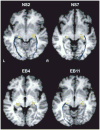Diffusion tensor imaging reveals white matter reorganization in early blind humans
- PMID: 16400157
- PMCID: PMC3789517
- DOI: 10.1093/cercor/bhj102
Diffusion tensor imaging reveals white matter reorganization in early blind humans
Abstract
Multiple functional methods including functional magnetic resonance imaging, transcranial magnetic stimulation, and positron emission tomography have shown cortical reorganization in response to blindness. We investigated microanatomical correlates of this reorganization using diffusion tensor imaging and diffusion tensor tractography (DTT). Five early blind (EB) were compared with 7 normally sighted (NS) persons. DTT showed marked geniculocalcarine tract differences between EB and NS participants. All EB participants showed evidence of atrophy of the geniculocortical tracts. Connections between visual cortex and the orbital frontal and temporal cortices were relatively preserved in the EB group. Importantly, no additional tracts were found in any EB participant. Significant alterations of average diffusivity and relative anisotropy were found in the white matter (WM) of the occipital lobe in the EB group. These observations suggest that blindness leads to a reorganization of cerebral WM and plausibly support the hypothesis that visual cortex functionality in blindness is primarily mediated by corticocortical as opposed to thalamocortical connections.
Figures





References
-
- Aldroubi A, Basser PJ. Reconstruction of vector and tensor fields from sampled discrete data. Contemp Math. 1999;247:1–15.
-
- Aleman A, van Lee L, Mantione MH, Verkoijen IG, de Haan EH. Visual imagery without visual experience: evidence from congenitally totally blind people. Neuroreport. 2001;12:2601–2604. - PubMed
-
- Amedi A, Raz N, Pianka P, Malach R, Zohary E. Early ‘visual’ cortex activation correlates with superior verbal memory performance in the blind. Nat Neurosci. 2003;6:758–766. - PubMed
-
- Andersen RA, Asanuma C, Essick G, Siegel RM. Corticocortical connections of anatomically and physiologically defined subdivisions within the inferior parietal lobule. J Comp Neurol. 1990;296:65–113. - PubMed
-
- Arno P, De Volder AG, Vanlierde A, Wanet-Defalque MC, Streel E, Robert A, Sanabria-Bohorquez S, Veraart C. Occipital activation by pattern recognition in the early blind using auditory substitution for vision. Neuroimage. 2001;13:632–645. - PubMed
Publication types
MeSH terms
Grants and funding
LinkOut - more resources
Full Text Sources
Miscellaneous

